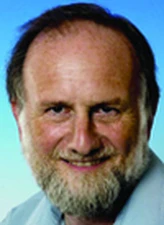Christopher A. Jones

The 2009 Petrus Peregrinus Medal is awarded to Christopher A. Jones for his insightful contributions to our understanding of rotating convection and the mechanism of generation of the magnetic fields of the Earth and other planets.
Over the last two decades Christopher A. Jones has made numerous important contributions to our understanding of the mechanism of generation of the magnetic fields of Earth and other planets, and to the study of rapidly rotating convection. As a result he has become one of the world leaders in this field. Of the contributions he has made to the subject only a handful can be chosen here to amplify his nomination for the Petrus Peregrinus Medal.
One of the long-standing and fundamental issues in the theory of the geodynamo is Taylor’s constraint. In the geophysical limit of very small viscosity and inertia, this requires that the magnetic field satisfy the condition that the net azimuthal electromagnetic torque must vanish for each cylinder coaxial with the rotation axis. The question of if and how Taylor’s constraint is satisfied in dynamo models is a delicate issue, to which Chris has contributed as much to as anyone. One of Chris’ early seminal papers (with A. Soward) in 1983 was on the subject of Taylor’s constraint in so-called α2 dynamos, a subject he returned to in the case of α-ω dynamos in 1988. A final contribution to this subject was in recent work with Jon Rotvig in a plane layer, where they provided arguably the first numerical demonstration of the approach to a Taylor state in a numerical plane layer dynamo model. This may be very important; numerical models have artificially high viscosity for reasons of numerical tractability and one of the big unknowns is how much further we need to go in reducing viscosity to achieve a realistic geophysical parameter regime.
In 1993, in a collaboration with Rainer Hollerbach, Chris made an important contribution to our understanding of the geodynamo problem by arguing the importance of the inner core. In a high profile Nature paper they argued that a conducting inner core serves to stabilise geomagnetic field generation in the core, and prevent reversals happening too frequently. Because a conducting inner core imposes a timescale on the core convection (effectively the free decay time for the inner core of a few thousand years), a reversal can only happen when the outer core convection manages to be sufficiently persistent to successfully reverse the magnetic field in the inner core. This observation had a profound effect on the geodynamo modelling community, who then began to accommodate conducting inner cores into their models, which had previously been deficient.
The subject of the onset of convection in a rapidly rotating sphere is an important problem with a long heritage. The question is what form the convection takes as the Ekman number becomes asymptotically small, as is the case for the Earth, and what are the critical Rayleigh numbers, wavenumbers and frequencies. The early breakthrough was made by Paul Roberts in 1968, but it took more than 20 years before the last word on the subject was given in Chris’ Journal of Fluid Mechanics paper of 2000 in a mathematical tour de force. In this very difficult paper Chris and his coworkers showed the shortcomings of the local theory and demonstrated that what was needed was a global theory. They went on to completely solve the problem and effectively close the subject once and for all. This analysis has now been extended to include the effect that magnetic fields have on the solution, bringing a new set of theory for understanding both the Earth and controlled laboratory experiments.
Chris’ contributions have not stopped on the Earth, but indeed have stretched to the outer planets, with work on Jupiter and Saturn and magnetic field generation in Io and Ganymede. His most recent work is a major contribution to explaining the generation of the multiple jet structure of Jupiter’s winds.
By nature Chris is a very modest and unassuming character, always with interest and time to discuss science with anyone from students upwards. Despite his vocation as an applied mathematician, he pays great heed to the latest observational results pertinent to the core, whether they be of a palaeomagnetic, geomagnetic, geodetic or seismological nature. He also follows carefully the experimental work relevant to the core. As an observationalist, I have personally become acutely aware just how keenly Chris takes in the latest results and developments, if he considers they will bring added insight to the dynamo problem. Chris has become the lead speaker of choice at international symposia on the geodynamo, as his CV will attest, because he has the knack of communicating a difficult subject effectively, and is also able to really identify the key issues. Chris conveys a real desire and enthusiasm to fully understand rotating convection and the workings of the geodynamo.
Through his career Chris has been an effective mentor to many students and postdoctoral researchers who have gone on to have successful careers as faculty members, among whom we can name Carlo Barenghi, Graeme Sarson and Rainer Hollerbach.
